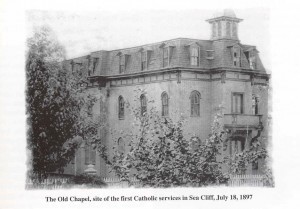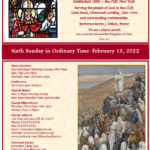In 1668, Joseph Carpenter and a few associates purchased a large tract of land on the North Shore of Long Island from the Matinecock Indians. This area remained a quiet, rural settlement until a post-Civil War religious fervor showed itself along the Atlantic seaboard. In 1871, a group of Methodists from Manhattan and Brooklyn organized the Sea Cliff Grove and Camp Ground Association and bought 147 acres of property from the heirs of Joseph Carpenter. Over the next three decades, religious summer camp meetings and crowds of visitors transformed the area into a bustling resort town, complete with hotels, a ferry service, steamboat cruises and lovely Victorian homes.
On October 12, 1883, that Sea Cliff became an incorporated village composed of thirteen families and the pastor of the Methodist Church. As the village continued to grow, more Catholic families settled in the area. On July 18, 1897, the first Catholic services were held in the Old Chapel on 14th Avenue, just west of Central Avenue, where visiting clergymen came to Sea Cliff to conduct camp meetings. Father James McEnroe presided and was assisted by Father Frederick Lund. Throughout the following year the pair continued to travel from Glen Cove to say mass at the mission until plans for a new parish were realized.
In 1898, Bishop Charles E. McDonnell, the second Bishop of the Brooklyn Diocese, formed a new parish in Sea Cliff that he named St. Boniface Martyr, and appointed Father James J. Donohoe as first pastor. Father Donohoe celebrated his first Mass on July 3, 1898 in the Old Chapel. The Sea Cliff News of July 9, 1898 correctly predicted: “As Father Donohoe is a hustler, it will not be long before a handsome new church will be erected.”
Ground was broken for a church building on January 11, 1899, and volunteers (including many non-Catholics) carted bricks and fieldstone from the Glenwood Landing dock and from the Long Island Railroad station in Glen Head. On June 11, 1899, the cornerstone for the church building was laid.
As the church was being erected, the work of building the parish also proceeded. Father Donohoe set up a Sunday School and organized a Junior Choir, formed an Apostleship of Prayer, arranged for a mission, got the Holy Name Society underway, organized the St. Aloysius and Holy Angels Sodalities, took the first census, celebrated the first confirmation, and trained the first altar boys. He set up the St. Boniface Guards for youth aged 9 through 15. He bought an old boarding house, turned it into a rectory, and held a special collection to furnish it. Instead of charging pew rent, as was the custom, an “admission fee” of ten cents was taken at the door as one entered for mass.
The social life of the church blossomed, all with the point of fund-raising. A news account of the time tells of “lectures, balls, stereopticon views, picnics, minstrel shows, fairs (one in 1897 netted $1200), concerts, lawn parties, open-air dancing, euchre (card) parties and suppers…”.
The moment the basement of the church was completed, Father Donohoe again appealed for the parishioners to harness their horse teams to carry chairs, benches and an altar to the site, where mass was celebrated on July 9, 1899. The completed church building was dedicated by Bishop Charles E. McDonnell, D.D., on April 22, 1900.
A Temperance Society was begun in April 1901 and lasted for only five years (records indicate a yearly decrease in numbers).
In 1902, the first St. Patrick’s Day Supper was celebrated, and netted $142.40. It soon became the parish event of the year, attracting people from the whole Oyster Bay peninsula. Its eat-all-you-like meal, prepared and served by the Ladies Guild in an atmosphere of carefree joy, was finally discontinued in the 1950’s for lack of ability to handle the crowds.
Father Donohoe was transferred in 1906 to St. Martin of Tours in Brooklyn, and Reverend William L. O’Hara became the second pastor at St. Boniface Martyr (1906-1909). He soon became known for his civic interest, his instruction of non-Catholics, and his generosity. In June of 1906, he gave the commencement address at the Sea Cliff High School graduation exercises. It was he who urged his parishioners and others in Sea Cliff to send money to aid those suffering from the San Francisco earthquake and, later, to collect for victims of an earthquake in Italy.
The pastor who followed Reverend O’Hara was by disposition apparently something of a local John XXIII (before his time). The Rev. Louis J. Sloane, who served until 1926,
managed to pay off the church debt and began the dream of a parochial school. To this end, he started to build a treasury.
Father Sloane was known for his great charity toward all people. He was well liked by non-Catholics in town and made many converts. When Father Sloane was suffering from his last illness, public prayers for his recovery were said in all the Protestant churches in Sea Cliff and in the Jewish Synagogues in Glen Cove. During the last two years of Father Sloane’s pastorate, Reverend Aloysius H. Gillick and Reverend William Rhatigan served as administrators.
A new church bell was blessed on Thanksgiving Day, 1916, and began to ring out the Angelus three times each day and to call the parish to divine worship. Weighing one thousand pounds, the bell was made by the Meneely Bell Company of Troy, New York, and was donated by Miss Mary A. Neville. It now sits in a small brick tower adjacent to the main church building and still rings joyously to this day.











Speak Your Mind